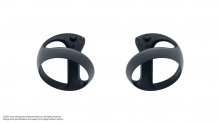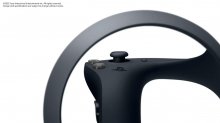Next-gen PS VR controllers revealed
Sony has just given us a glimpse of its next-gen VR controller via a new blog post from Hideaki Nishino, Senior Vice President, Platform Planning & Management. It lacks the "orb" design of the old-gen one and adopts a design more akin to other VR controllers, while still packing an original look. The company says that "it’s well-balanced and comfortable to hold in each of your hands".
These new controllers are also said to enable players to "feel and interact with games in a much more visceral way" and borrows some features from the PS5's DualSense controller to do so. As per the announcement, you can find some of the key features below:
● Adaptive triggers: Each VR controller (Left and Right) includes an adaptive trigger button that adds palpable tension when pressed, similar to what’s found in the DualSense controller. If you’ve played a PS5 game, you’ll be familiar with the tension in the L2 or R2 buttons when you press them, such as when you’re drawing your bow to fire an arrow. When you take that kind of mechanic and apply it to VR, the experience is amplified to the next level.
● Haptic feedback: The new controller will have haptic feedback optimized for its form factor, making every sensation in the game world more impactful, textured and nuanced. When you’re traversing through rocky desert or trading blows in melee combat, you’ll feel the difference, magnifying the extraordinary visual and audio experience that’s so central to VR.
● Finger touch detection: The controller can detect your fingers without any pressing in the areas where you place your thumb, index, or middle fingers. This enables you to make more natural gestures with your hands during gameplay.
● Tracking: The VR controller is tracked by the new VR headset through a tracking ring across the bottom of the controller.
● Action buttons / analog sticks: The Left controller contains one analog stick, the triangle and square buttons, a “grip” button (L1), trigger button (L2) and Create button. The Right controller contains one analog stick, the cross and circle buttons, a “grip” button (R1), trigger button (R2) and Options button. The “grip” button can be used to pick up in-game objects, as one example.
What do you think of these new VR controllers?











 hmmm I'm a terrible pirate lol
hmmm I'm a terrible pirate lol